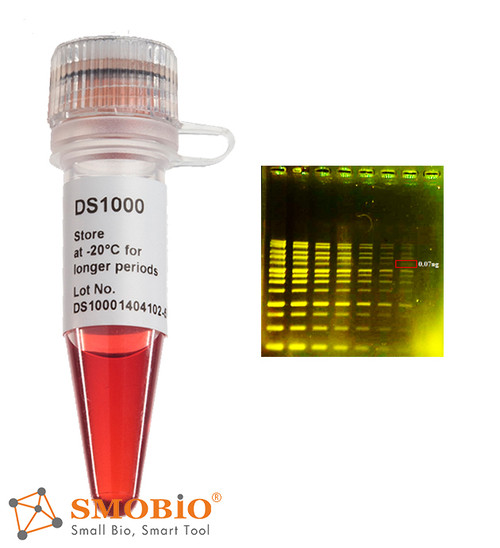

The FluoroVue™ Nucleic Acid Gel Stain (10,000X) is specially designed for in-gel use and is a safer replacement for conventional Ethidium bromide (EtBr), which poses a significant health and safety hazard for its user. It is a fluorescent stain which offers high sensitivity detection of double-stranded or single-stranded DNA and RNA in a convenient manner.
The FluoroVue™ Nucleic Acid Gel Stain offers high sensitivity (Table 1 and Fig. 2) that is several times greater than EtBr.
For detailed protocols of different staining methods: please see pages 5~7. We recommend using an in-gel staining method for optimal effect. 1 With a mini horizontal gel electrophoresis system: Combine 40 ml of agarose gel with 300 ml running buffer. The regular post staining buffer volume is 100 ml. 2 Sensitivity is evaluated according to the 4 kb band of DM3100
FluoroVue™ Nucleic Acid Gel Stain is compatible with both conventional ultra violet gel-illumination systems as well as the harmless long wave length blue light illumination systems. When bound to nucleic acids, the FluoroVue™ Nucleic Acid Gel Stain has a fluorescent excitation maximum of ~250 and ~482 nm, and an emission maximum of ~509 nm (Fig. 2). Therefore, it can replace EtBr without the need for changing existing lab imaging systems.
See more information in the product literature HERE.
Caution
Dispose of the stain in accordance to local rules and regulations. The fluorescent staining dye stock solution should be handled with particular caution because the solvent is known to facilitate the entry of organic molecules into tissues. There is no data that addresses the mutagenicity or toxicity of the fluorescent dye in humans. However, the fluorescent dye binds to nucleic acids, thus it should be recognized as a potential mutagen and used with appropriate care.
Features
1. Excellent for in-gel staining
2. Sensitivity: 0.14 ng (DNA) or 1 ng (total RNA)
3. A safer alternative to EtBr
4. Compatibility: suitable to blue or UV light
5. Increased cloning efficiency (blue light)





Oops, something went wrong. Please try again.
You are now logged in!
